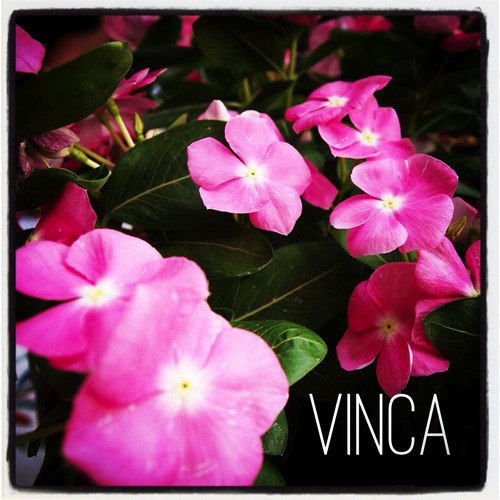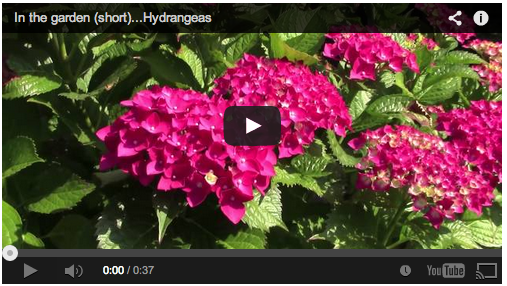Vinca
These lovely Vinca flowers comes from the garden of our Sicilian family near Mascalucia, Francesca had several lovely pots of these flower scattered around the yard. This was her garden, close to the house and distinct from the more “productive” garden of fruit and nut trees and a large free-growing patch of basil behind the house.

Follow DouglasWelch in Instagram
Vinca (/ˈvɪŋkə/;[2] Latin: vincire “to bind, fetter”) is a genus of six species in the family Apocynaceae, native to Europe, northwest Africa and southwest Asia.[3][4][5] The English name periwinkle is shared with the related genus Catharanthus (and also with the common seashore mollusc, Littorina littorea). In India the plant is known as sadaphuli meaning “always flowering”.
Vinca plants are subshrubs or herbaceous, and have slender trailing stems 1–2 m (3–6 feet) long but not growing more than 20–70 cm (8-30 inches) above ground; the stems frequently take root where they touch the ground, enabling the plant to spread widely. The leaves are opposite, simple broad lanceolate to ovate, 1–9 cm (0.25–3.5 inches) long and 0.5–6 cm (0.25–2.25 inches) broad; they are evergreen in four species, but deciduous in the herbaceous V. herbacea, which dies back to the root system in winter.[6][7]
The flowers, produced through most of the year, are salverform (like those of Phlox), simple, 2.5–7 cm (1–3 inches) broad, with five usually violet (occasionally white) petals joined together at the base to form a tube. The fruit consists of a pair of divergentfollicles; a dry fruit which is dehiscent along one rupture site in order to release seeds.[6][7]
There are at least 86 alkaloids extracted from plants in the Vinca genus.[12] The chemotherapy agent vincristine is extracted from Vinca rosea (current name Catharanthus roseus), and is used to treat someleukemias, lymphomas, and childhood cancers, as well as several other types of cancer and some non-cancerous conditions. Vinblastine is a chemical analogue of vincristine and is also used to treat various forms of cancer.[13] Dimeric alkaloids such as vincristine and vinblastine are produced by the coupling of smaller indole alkaloids such as vindoline and catharanthine.[14]— Wikipedia
More information on Honey bees:
- Acanthus
- Amaryllis
- Apricot (Prunus armeniaca)
- Aspen
- Azalea
- Banana
- Bonsai
- Bougainvillea
- Brugmansia
- Butterfly (Lepidoptera)
- California Flannelbush (Fremontodendron californicum)
- California Poppy (Eschscholzia californica)
- Calla Lily (Zantedeschia aethiopica)
- Campsis radicans
- Castor Bean (Ricinus)
- Caltapa
- Chives (Allium schoenoprasum)
- Clematis
- Camellia
- Currant (Ribes)
- Dahlia
- Datura
- Japanese Cherry (Prunus serrulata)
- Daffodil (Narcissus)
- Dietes (Fortnight Lily)
- Dudleya
- Echinacea
- Ecualyptus
- Ficus benjamina
- Freesia
- Fungi
- Gerbera Daisy
- Grape (Vitis vinifera)
- Helianthus (sunflower)
- Hibiscus (Malvaceae)
- Honeybee
- Iris
- Jacaranda mimosifolia
- Joshua Tree (Yucca brevifolia)
- Kniphofia “Red Hot Poker”
- Lantana
- Lavender (Lavendula)
- Kousa Dogwood (Cornus kousa)
- Magnolia x soulangeana (Saucer Magnolia/Tulip Tree)
- Mandevilla
- Magnolia Grandiflora
- Marigold (Calendula officinalis)
- Matilija Poppy (Romneya)
- Morning Glory (Convolvulaceae)
- Nandina
- Oleander (Nerium)
- Orange
- Orchid from the Southern California Spring Garden Show 2013
- Oriental Poppy (Papaver orientale)
- Polygonatum (Solomon’s Seal)
- Paperwhites
- Pineapple (Ananas comosus)
- Primula (Primrose)
- Queen Anne’s Lace (Daucus carota)
- Rosa ‘Mikado’
- Rudbeckia
- Salvia
- Squirrel
- Star Jasmine (Trachelospermum jasminoides)
- Succulents
- California Sycamore (Platanus racemosa)
- Sweet Potato (Ipomoea batatas)
- Tomato
- Water Lily (Nymphaeaceae)
- Wisteria






